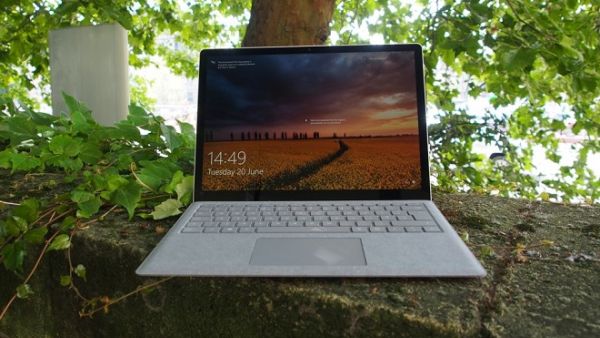As we contemplate the possibilities of a Surface Laptop 2, let’s take a moment to reflect on the successes and shortcomings of the original Surface Laptop.
Released last June, the Surface Laptop was Microsoft’s first attempt at a non-convertible clamshell notebook. It was a way to appeal to the fans of the Surface Pro who wanted a larger screen and included keyboard without alienating those who can’t afford the Surface Book or its sequel.
Without the hybrid form factor, it’s able to remain focused on being a laptop above all else, ditching all the frills Microsoft’s hardware has been known for since the original Surface Pro. Better yet, a recent firmware update has mitigated the battery live concerns of the past, forging improved stability as opposed to the less consistent battery life performance we had before. It isn’t too expensive either, but it comes with the catch of leveraging a new operating system you may not be familiar with – namely Windows 10 S.
That’s right, out of the box you’ll only get access to Windows Store applications, unless you upgrade your Surface Laptop to the Pro version of Windows 10. You can do this for free right now, but you don’t have much longer to do so. Microsoft has claimed in the past that this offer is set to expire in March 2018, though the exact time and date isn’t quite clear.
Otherwise, the Surface Laptop has been well-received, and it’s not hard to see why either. Unlike the lot of Windows machines out there, the Surface Laptop is worth buying at the most affordable level. Now starting at the same cost as the Surface Pro, you’ll have to decide whether a larger screen is worth sacrificing the versatility of a 2-in-1 form factor.
That, and all else considered, let’s take a look at how the Surface Laptop stacks up to its main competitors. Provided the empire Apple has concocted over the years, could the Surface Laptop finally be the one to give its MacBooks a run for their money?

Price, availability and value
A premium device commands a premium price tag, and the Surface Laptop now starts at $799 (around £560, AU$1,000) and comes with an Intel Core m3-7Y30 processor, 4GB of RAM and 128GB of SSD storage. However, that model is only available in the US as it stands currently.
In order to upgrade to that CPU to an i5, you’ll have to reach a little deeper in your wallet for $999 (£979, AU$1,499). More specifically, that price nets you a 2.5GHz Intel Core i5-7200U, along with the same 4GB of RAM and 128GB SSD in the US, UK and Australia.
The next configuration up includes the more powerful Intel Core i7 processor, 8GB of RAM and 256GB SSD for $1,599 (£1,549, AU$2,449). Finally, you can pick up a Microsoft Surface Laptop with an Intel Core i7 processor, 16GB of RAM and 512GB storage for $2,199 (£2,149, AU$3,299).
Are these upgrades worth the price hikes? While the doubling of storage space gives it more flexibility, there are cheaper ways of getting more space to save your files to – including cloud services such as Google Drive.

However, 16GB of RAM will be tempting to some people who want to use the Surface Laptop for running demanding software or multitasking numerous applications at once. Those users will likely want to upgrade from Windows 10 S – which only allows apps to run if they've been downloaded from the Windows Store – to Windows 10 Pro, which will cost an additional $49 (around £40, AU$65) after December 31 2017 (before then the upgrade is free).
For most people, however, the cheapest Surface Laptop configuration should be absolutely fine – especially if you’re using Windows Store apps, which have been vetted and tested by Microsoft.
One of the ideas behind Windows 10 S and its restriction to Windows Store apps is that those apps are less resource-hungry than traditional Windows applications, which means they'll run well on lower-power machines, and should drain the battery slower too.
The price of the Surface Laptop puts it in the same bracket as last year’s MacBook, as well as the HP Spectre x360 and Dell XPS 13, while offering slightly better specs and power for the base model than the MacBook, but less than the HP and Dell machines.
All three of these competitors are worthy adversaries, appearing high up in our list of the best laptops in 2017 – so the Surface Laptop definitely has its work cut out for it.

The Surface Laptop in traditional 'Platinum'
Design
In our hands-on review of the Surface Laptop we suggested that this 13.5-inch machine is quite possibly the most attractive computing product Microsoft has ever created – and now that we've spent more time with it, we stand by that statement.
In short, the Surface Laptop is an incredibly attractive machine which shows that Windows laptops can be just as gorgeously designed as Apple products.
It features a full aluminum lid and body reminiscent of the Surface Book's, which give it a sturdy yet premium feel. While these keep the Surface Laptop feeling light (more on that in a bit), they also give you confidence that this expensive bit of kit isn’t going to break or dent easily at the merest of knocks.

Unlike the Surface Book, the Surface Laptop doesn’t feature an aluminum keyboard – instead Microsoft has opted for plastic keys. Before you start to worry that this could lead to the Surface Laptop feeling a bit cheap, it also features Alcantara fabric material, which is imported from Italy and laser-cut to fit the keyboard and which gives the Surface Laptop a very pleasant feel, especially when typing.
The key travel of the Surface Laptop’s keyboard also feels satisfying, with 1.5mm of travel giving you a decent physical response when typing. A cool design feature places the Surface Laptop’s speakers behind the keyboard, using the gaps between the keys as a sort of grille.
It means the body can remain slim, with no speakers to add to the overall size, and this compromise works very well, with sound from the Surface Laptop coming through loud and clear – though we noticed a bit of muffling when typing at the same time. This may be an issue if you enjoy listening to Spotify while working, but at least the included audio jack allows you to hook up the Surface Laptop to an external speaker.

Those strange strips of plastic on the base? They're Wi-Fi antennae
Speaking of ports, the Surface Laptop comes with a USB 3.0 port, Mini DisplayPort and Microsoft's proprietary Surface Connect power and docking port, as found on other Surface devices.
The newer, faster USB-C connection is conspicuous by its absence. When we spoke to Microsoft about this, they told us that it intends for connectivity expansion to be handled via its Surface Connect port and Surface Dock.
Nevertheless, it’s a shame to see there’s no USB-C port, as an increasing number of peripherals are coming out with this connection, and many of the Surface Laptop’s competitors include it.
On the other hand, though, we’re also relieved that Microsoft hasn’t followed Apple’s USB-C or nothing approach.
The limited number of ports mean the Surface Laptop can maintain a thin profile – in fact it measures just 14.48mm thick, making it thinner than the Dell XPS 13’s 15mm, though slightly thicker than the MacBook at 13.1mm and the HP Spectre at 13.7mm.

So, while it’s not the thinnest laptop around the Surface Laptop is still pretty darn slim, and it weighs just 1.25kg, which is lighter than the Dell’s 1.29kg, though again it’s more weighty than the MacBook, which tips the scales at 1.08kg.
Still, it’s impressively light, and easy to hold in one hand. For carrying around, this is one of the most comfortable laptops you can buy.
The thinness of the design does have a drawback, however, as the Surface Laptop is incredibly hard to fix, and impossible to upgrade. This was discovered by the iFixit website, which took apart a Surface Laptop and found that many things are either glued in, or soldered to the motherboard, which makes removing and replacing parts extremely difficult. This may not be a worry for some, but if you damage your Surface Laptop, or something goes wrong out of warranty, then it may prove to be quite expensive.

A comparison with the Surface Book
The screen is a bright and vibrant 13.5-inch PixelSense touchscreen display, which is reinforced with Corning Gorilla Glass 3 for protection against scratches. The resolution is 2256 x 1504, which gives it a pixel density of 201ppi (pixels per inch).
Resolution fans out there (come on, there must be some) will notice the slightly unusual resolution here, which is due to the Surface Pro’s screen having a 3:2 aspect ratio – most laptop (and monitor) aspect ratios are 16:9 (with MacBooks being 16:10).
What this means in practice is that the Surface Laptop’s screen is taller, which gives you a bit more screen room when working – though it does mean that if you’re watching widescreen videos you’re going to get larger black bars running along the top and bottom of the screen.

The Surface Laptop's keyboard deck is awfully comfortable
The aspect ratio of the screen has implications for the size of the Surface Laptop as well, with the device having a wider body due to it.
Overall, though, the Surface Laptop is a fantastic-looking device that will certainly turn heads when you take it out to use it, while still feeling comfortable to work on and carry around.
As we've mentioned, the Surface Laptop will come in a number of configurations – though at the time of writing only the lowest-spec configurations are available.
That doesn’t mean the Surface Laptop is underpowered. In fact, even the base model comes with some pretty impressive components, including a seventh-generation Intel Core i5 processor clocked at 2.50Ghz.
This is a much more accomplished processor than the sixth-generation Intel Core m5-6Y54 that powers the 2016 version of the MacBook, while the base model of 2017’s MacBook uses the newer Intel Core m3-7Y32 CPU, which is still a step down from the Surface Laptop’s Core i5.
The HP Spectre x360 fares better in the CPU comparisons, coming with a 2.7GHz Intel Core i7-7500U processor (and more RAM at 16GB), for only a bit more cash ($1,049/£1,199/ AU$2,299$), and it’s quite a bit cheaper than the i7-toting variant of the Surface Laptop.
While the i5 CPU is a great addition, the 4GB of RAM in the base version of the Surface Laptop feels a little tight, especially when its competitors are offering two or four times as much RAM. While 16GB (and certainly anything above that) of RAM is excessive in a laptop for many day-to-day tasks, it does mean that more intensive programs – such as photo- and video-editing apps – may lag, while you may also see some slowdown if you want to run a number of programs at the same time. The version we reviewed came with 8GB of RAM, which means it’s more powerful than the base version of the Surface Laptop.

The argument for this relative paucity of RAM is that the Surface Laptop is limited to running apps from the Windows Store, which are less memory-intensive than normal Windows programs. So, if you stick with Windows 10 S, the lack of RAM shouldn’t be too much of an issue – but if you upgrade to Windows 10 Pro and aim to run more ambitious programs, then you may soon get frustrated. As we mentioned earlier, the design of the Surface Laptop means components are soldered to the motherboard, so you won’t be able to open up your device and install additional RAM if it begins to slow down.
To keep the components cool while ensuring that the Surface Laptop runs silently, Microsoft has included a brand-new proprietary vapor chamber cooling system. This works by changing the physical state of the heat as it's taken in through the center of a fan vent in the rear of the laptop base and spitting it out of the sides of that same vent.

Note the Surface Connect dock port – Microsoft's answer to USB-C
Performance
Before we begin talking about the performance of the Surface Laptop, we need to highlight an issue with our usual testing methodology. Usually we run a range of benchmark tests on laptops we review, which stress-test the devices and give us scores that help us compare and contrast to rival products.
These benchmarks, alongside our day-to-day testing of the devices, give us a good idea of how well the laptops perform. The issue here is that many of these benchmarking apps, including GeekBench 4, 3DMark and PC Mark, are not available through the Windows Store, which means they can't be run on Windows 10 S.
While we would be able to run these tests on the Surface Laptop by upgrading it to Windows 10 Pro, the PR team that sent us the review sample asked us not to do so.
So we aren’t able to give you direct comparisons of benchmark results, but we can tell you how it felt to use – which in many ways is more important.
It’s also worth noting that Windows 10 S has been designed so that a device feels as fast and smooth to use on its one thousandth day of use as on its first day of use. This is because Windows Store apps are installed in a sandboxed environment, which means they can’t make changes to the registry or other important Windows settings, in the way normal Windows applications sometimes do. It also means they can easily be installed and uninstalled without leaving any traces behind.
While we sadly can’t test out the thousand-day claim, our time with the Surface Laptop proved that even with the lowest-specification version, Windows 10 S ran extremely well, with the various apps we used opening and closing smoothly.
There are a number of games available on the Windows Store, and we tried out a few of these. These are simple, mobile-like games, so as you’d expect they didn’t trouble the powerful Surface Laptop.

While Windows 10 S does come with some nice features, the fact that it's limited to running Windows Store apps may annoy some people, as you may find that some of the programs you rely on don't have Windows Store versions.
While Microsoft is committed to bringing popular applications to the Windows Store, the process is long, and there's a good chance that there will be some tools you want to run that you just can’t. In these cases, the locked-down nature of Windows 10 S will become frustrating – and you may ask yourself why you spent a grand on a computer that doesn’t let you run your favorite programs.
Of course, there is the option to upgrade to Windows 10 Pro, and until the end of this year it's free to do so. However, by upgrading to Windows 10 Pro you miss out on the performance and security benefits of Windows 10 S. Microsoft had also said the upgrade was a one-way process, but it has thankfully back-tracked and you will be able to revert to Windows 10 S – though it will mean wiping your machine and losing all your installed programs and files.
If you’re worried about Windows 10 S being too restricted, then Microsoft seeks to ease those concerns by including a free one-year subscription to Office 365 Personal, which is a nice touch.
However, while we enjoyed our time with the Surface Laptop running Windows 10 S, if we were to continue to use it as our daily laptop we would have no option but to upgrade to Windows 10 Pro – there are just too many programs we rely on, not least web browsers such as Chrome (you’re stuck with Microsoft Edge on Windows 10 S).
However, running Windows 10 S on the speedy 256GB SSD was incredibly impressive, with instant wake from standby, and Windows 10 S loaded in a matter of seconds when booting from its fully-off state. This is a Windows laptop that you can reliably open up and begin working on straight away.
The touchscreen performed brilliantly, and was fast and responsive to our prods and gestures, especially when using a stylus and the Windows Ink handwriting and annotation feature of Windows 10.

The trackpad also felt good, and the longer vertical size of the body (due to the 3:2 aspect ratio of the screen) gives you a comfortable place to rest your palms as you type on the keyboard.
We were, at least, able to run our TechRadar battery benchmark, where we loop a high-definition video until the battery runs out. The Surface Laptop did very well, lasting 8 hours 47 minutes – making it an excellent choice for watching movies on long journeys.
We also used the Surface Laptop for moderately intensive work, including browsing the web, streaming music and using the included Office apps. The Surface Pro made it through the whole work day (9am to 5pm) with 20% of its battery left, which means you can safely use it for work without having to worry about charging.
Overall we were very impressed with the performance of the Surface Laptop, and thanks to Windows 10 S, and an absence of the crapware (preinstalled software you never want to use) that usually comes on Windows laptops, the Surface Laptop competes with – and sometimes outperforms – laptops with higher specifications.
We liked
The Surface Laptop is an absolutely gorgeous device, and Microsoft’s attention to detail when it comes to making a desirable – and slim – machine has paid dividends. This feels and looks like a premium device, while also feeling like a strong and robust machine that you wouldn’t worry about carrying around with you.
The Surface Laptop also punches above its weight when it comes to performance, mainly thanks to the well-utilized components and controlled environment of Windows 10 S.
We disliked
Speaking of Windows 10 S, its implementation here is going to prove divisive. Some people will embrace its simplicity and security, while others will find its restrictions frustrating. At least upgrading to Windows 10 Pro is free for the moment.
The locked-down nature of the Surface Laptop doesn’t stop at the software, though, as the hardware is also glued and soldered together to prevent easy upgrades or fixes. If you want more control, freedom and flexibility over your laptop, then this is not the device for you.
The price is also quite expensive compared to competing devices.
Final verdict
Microsoft is gaining a reputation for making solid, attractive and overall desirable premium products to showcase its Windows software, and the Surface Laptop continues in this vein. The thin and light design makes it easy to carry around, while the careful component considerations, and high-quality build materials, make it a joy to use.
This is obviously a device that Microsoft’s designers and engineers have spent a lot of time working on, and for the most part it has paid off handsomely. This is one of the best-looking Windows devices on the market today, and, thanks to some nifty specs that power the carefully controlled Windows 10 S operating system, it's one of the smoothest Windows 10 experiences too.
If you use Microsoft’s core tools, and can find everything you need in the Windows Store, then you're going to love the Surface Laptop.
For those who worry that Windows 10 S is too restrictive, the ability to upgrade to Windows 10 Pro is a welcome one, and for many people this will instantly make the device more useful and flexible.
It’s not quite perfect, however, and there are a few design choices that prevent it from achieving true greatness. The lack of USB-C is disappointing for such a forward-thinking device, and the lack of ports means you may have to resort to a USB adaptor hub to plug in various devices.
You’re also paying a price premium for this product – so there are more powerful (but less visually appealing) laptops out there for the same price – or cheaper.
Meanwhile, the glued and soldered makeup of the laptop will dismay tinkerers, or even people who just want to be safe in the knowledge that if something breaks, their expensive gadgets can be easily fixed. As it stands, you may have to get your Surface Laptop completely replaced if something breaks – even something that would be a relatively easy and cheap fix with other laptops.
- Kuwait: Expat Government Employees Need Double Clearance for New Visa
- Qatar, Social Apps and 2022 FIFA World Cup: Interview With Tech Entrepreneur Rola Fayyad
If you've completely bought into Microsoft’s ecosystem, and want a thin and light laptop that performs brilliantly with the minimum of fuss, then we can heartily recommend the Surface Laptop.
However, if you’d like more control over what you run on your machine, then there are other alternatives out there that would be better suited to your needs.
By








